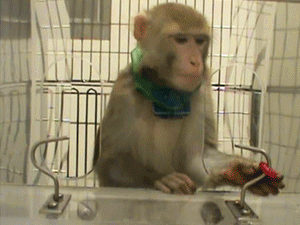
Safety trials add crucial piece to gene silencing jigsaw
Three trials of drugs to 'silence' the HD gene in monkeys show they hit the target safely. Human trials coming soon.

Gene silencing drugs aim to slow down or prevent Huntington’s disease by telling cells not to make the harmful protein. For the first time, a study has shown that gene silencing hits its target and is safe in the complex brains of rhesus monkeys.
Gene silencing – the elevator pitch
Ask a Huntington’s disease researcher what they think is the most promising treatment in development, and there’s a good chance they’ll say ‘gene silencing’. Our HDBuzz article ‘Gene silencing: the story so far’ will give you the full lowdown on gene silencing – but here’s a quick recap.

Image credit: Nature Publishing Group
Each cell in your body contains two copies of the HD gene, one inherited from each parent. Huntington’s disease is always caused by the same basic ‘spelling mistake’ in one copy of the HD gene.
Proteins are the chemical machines that do all the important stuff in cells, and a gene is a recipe that tells cells how to make a protein.
The abnormal HD gene causes cells to produce an abnormal protein, which we call ‘mutant huntingtin’. It’s the mutant huntingtin protein that damages cells, eventually leading to the symptoms of Huntington’s disease.
If a house is flooding because the bath’s overflowing, the obvious solution would be to turn off the flow of water. That’s basically what gene silencing therapy aims to do for Huntington’s disease – tell the cells to stop making the harmful protein.
Our genes are made of DNA, and when a cell makes a protein, it creates a ‘working copy’ of the DNA, from a related chemical called RNA. You can think of RNA as a working copy of the gene, or a ‘message molecule’.
Gene silencing involves specially designed drugs that stick to the HD message molecule, and tell cells to remove it, rather than using it to build proteins. The result is that less protein is made.
What has gene silencing done so far?
Gene silencing has already been shown to slow down the progression of Huntington’s disease symptoms in HD mice and rats, resulting in improvements in both symptoms and brain damage, even after the disease has begun. And all the evidence so far is that a small reduction in huntingtin levels produces a sustained improvement.
So far, gene silencing has cleared every hurdle it’s needed to. We are now close to testing gene silencing drugs for HD in human trials. One key question that remains is whether they’re safe to use.
Assessing drug safety
For people affected by HD, it’s tempting to scream “just give me the drugs!”, because it feels like any drug side effect would be preferable to a life with HD or at risk.
But in reality, no drug will be approved for human use until it has been proven to be safe. HD is a slowly progressive disease, where treatments may need to be taken for many years. New drugs could have unexpected side effects even worse than the symptoms of HD. And in the worst case scenario, a drug could even accelerate the disease.
So, it really is crucial to establish that a drug is safe to use in humans before clinical trials in patients are begun.
Why test on monkeys?
Compared with the human brain, the brains of mice and rats are tiny, and much simpler. On top of that, gene silencing drugs don’t cross easily from the blood into the brain, so they have to be injected directly into the brain, or the fluid around it. This delivery problem is being worked on, but it’s unlikely to change soon. For now though, these invasive procedures are the price we’re likely to have to pay for switching off the HD gene.
Gene silencing is a new and powerful approach, so it’s essential that it’s tested in larger and more complex brains, to assess the safety of both the drug and the surgical techniques used to deliver it.
“Drug-treated animals did no worse on the movement tests during the six-week observation period”
A team of researchers led by Dr Beverly Davidson at the University of Iowa and Jodi McBride at the Oregon Health and Science University, is one of several working on gene silencing drugs for HD. Success of their drug in rodents led them to the next step – testing it in the more advanced brain of primates – rhesus monkeys, to be precise.
The results of their research – the first published safety trial of HD gene silencing in a primate – have just been announced in the journal Molecular Therapy.
Primates are only used in medical research when there’s no other alternative, and their use is strictly regulated to make sure that the very smallest number of animals is used, and the animals are treated as humanely as possible.
The drug
Gene silencing drugs come in two basic ‘flavors’ – RNA interference (RNAi) drugs, which closely resemble the message molecule chemically, and antisense oligonucleotide (ASO) drugs, which are less similar but can spread further within the brain. These flavors are being studied at the same time by several teams around the world.
Another choice researchers have to make when designing a gene silencing drug is whether to target all the huntingtin message molecules, or just the ones for the mutant protein. Targeting just the mutant ones could be safer, but is harder to do. Again, at the moment we don’t know which is best so both options are being worked on.
Each of the two copies of the huntingtin gene in our cells – one from mom, one from dad – is called an ‘allele’. Drugs that target just the mutant huntingtin message are called ‘allele-specific’, while those aimed at all huntingtin message molecules are ‘allele-nonspecific’.
Davidson’s gene silencing drug is an RNAi drug that’s allele-nonspecific.
The trial
Because it’s an RNAi drug, it has to be injected directly into the brain. Davidson’s team chose a target called the putamen. The putamen is a deep brain structure crucial for controlling movement, which is involved early in the course of Huntington’s disease.
To help the drug to spread further, the drug was packaged into an inactivated virus called AAV.
The purpose of this trial wasn’t to show whether the drug slows down HD, but to assess its safety. So animals in this trial didn’t have an abnormal HD gene – they each had two normal copies of the gene.
Twelve rhesus monkeys were given injections – four received the virus containing the drug, four got the AAV virus containing a dummy drug, and four were just injected with saline solution. Each monkey received six injections at the same time – three into the left putamen and three into the right.
Before the injections, the monkeys’ fine movement skills were assessed by timing how quickly they could remove a sweet treat from a metal rod. Motion-sensitive collars were used to measure how much the monkeys moved each day. A neurological examination similar to the one used in HD patients was specially designed to detect any subtle movement problems in the monkeys. Importantly, the researchers carrying out the assessments didn’t know what treatment the animals had received.
The drug hit its target
Six weeks after the injections, the monkeys’ brains were examined under the microscope. The results were good – in the treated animals, the brain around the injection sites had about half the amount of huntingtin message molecules as in the untreated monkeys. Encouragingly, there were signs that the drug had spread up and down the neurons from the putamen into neighboring brain regions.

The drug was safe
Understandably, all the monkeys were less active in the week after surgery, but the animals that received the active drug were no worse than the others, and they all bounced back pretty quickly. Drug-treated animals did no worse on the movement tests during the six-week observation period, suggesting that the drug was safe. And there was no sign of abnormal inflammation or extra damage to neurons in the treated animals.
Cleverly, the researchers included an extra test to look for subtle side effects on the ability of the monkeys to learn new movements – a key job of the putamen. As well as the simple treat-on-a-rod test, they introduced a more difficult test where the monkeys had to remove a treat from a rod shaped like a question mark. Reassuringly, the drug-treated animals were just as good as the others at learning this new task.
Was there a downside?
Though the trial was a success for the safety of the drug, a couple of reservations are worth noting. One of the animals that received injections of dummy drug developed problems with movements in its leg – probably a direct effect of the brain injections. This reinforces the fact that there’s no such thing as minor brain surgery.
And though the RNAi drug spread as far as expected, the total volume of brain that was treated was still small, and the drug didn’t reach distant areas known to be affected in HD, like the cortex – the brain’s wrinkly surface. Scaling this trial up to human brains – still much larger than monkey brains – is a challenge.
Finally, it’s worth repeating that this trial can’t tell us whether the drug would actually slow down or prevent HD in humans – the monkeys in this safety trial each had two normal copies of the HD gene.
You wait ages for a primate gene silencing trial…
… then three come along at once.
Davidson’s work is the first HD gene silencing primate trial published in a scientific journal. But at the recent World Congress on Huntington’s Disease, two other groups working on gene silencing announced separate successes in monkey trials.
A team from the University of Kentucky, working with the surgical implant manufacturer Medtronic, has studied allele-nonspecific RNAi over six months and found no major safety problems. Meanwhile, Isis Pharmaceuticals in California, announced that injection of an ASO drug into the fluid at the base of the spine – a relatively minor procedure – produced a 50% reduction in the huntingtin message throughout the brain. We need to wait for the published results of these studies before drawing conclusions, though.
Summing up
These are exciting times. Gene silencing drugs are already approved in several other human diseases, and a human trial has been going on for nearly a year in motor neuron disease – a neurodegenerative disease like HD.
Right now, we could easily have been in a position where monkey safety trials had raised major concerns about moving into human patients – but instead, three trials have shown that the drug hits its target safely in large, complex brains.
Building on these successes, plans are afoot for human gene silencing trials. It’s likely these will happen within two years, in small numbers of patient volunteers. If things go well, larger trials will follow until there’s enough evidence to get a drug approved.
Be warned: there’s lots that could go wrong, and the road ahead will have its twists and turns. But so far, things are coming together well, and gene silencing remains a top candidate in the quest for disease-slowing treatments for HD.
Learn more
Sources & References
For more information about our disclosure policy see our FAQ…


